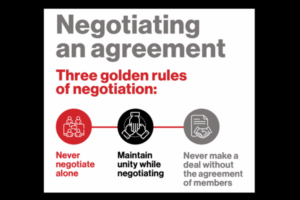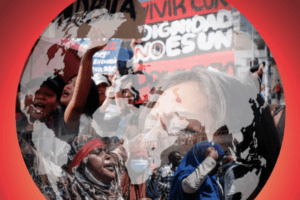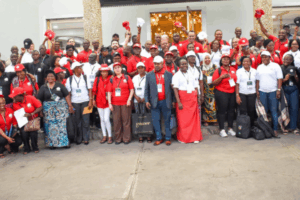The proposed International Labour Organisation (ILO) standard on ending violence and harassment against women and men in the world of work is extremely important. Some people may argue that the issue of violence and gender-based violence (GBV) is addressed by other conventions and recommendations, but a stand-alone convention and recommendation are essential given the way violence has been normalised.
The two significant movements, the #MeToo movement and the Total Shutdown Intersectional Women’s Movement against GBV (#TotalShutdown) highlighted the pervasiveness of gender-based violence in the world of work in both well-known and powerful industries and marginalized sectors often invisible to public scrutiny. This also demonstrates the prevalence of violence at work and how it is both tolerated and endured by an especially high percentage of women seeking to obtain or maintain employment.
This paper will focus on:
- The need for a stand-alone standard on ending violence and harassment in the world of work;
- The impact of violence and harassment on women workers in the workplace;
- Strategies to put gender-based violence on the trade union movement and workplace agenda;
- A new approach to collective bargaining; Strengthening the hand of the trade unions to give gender-based violence greater prominence, urgency and ensure that there is equal application to individuals of any gender identity and to all workplaces.
Demanding a new global standard
There are more than 500 multilateral treaties aimed at protecting nations against a variety of ills, from anti-corruption measures and control of greenhouse gas emissions to those that tackle doping in sports and substance misuse. Despite this, no single UN treaty addresses violence and harassment in the world of work.
In its 2016 meeting of experts, the ILO noted that gaps in legal protections relating to violence and harassment in the world of work include a lack of coherence in laws; a lack of coverage of workers most exposed to violence; and an overly narrow definition of the term “workplace.” The ILO also noted that criminal justice approaches are not sufficient for responding to sexual harassment and bullying and that an employer’s general duty to protect the health and safety of workers often excludes protection from violence. Where laws do exist, they are often weak, or their related policies, practices and resources are too inadequate to be effective.
A study by the World Policy Analysis Centre revealed that more than one-third of the world’s countries have no laws against sexual harassment at work, leaving nearly 235 million women vulnerable. Similarly, the World Bank’s “Women, Business and the Law 2018” report found that 59 out of 189 economies had no specific legal provisions covering sexual harassment in employment.
A global coalition of trade unions, gender activists, labour rights and human rights organisations are demanding a new global standard to end violence and sexual harassment in the workplace.
A global convention on ending violence and harassment in the world of work has the power to offer recourse, protection and savings by reducing costs of absenteeism, turnover or litigation. A convention with a strong focus on preventing and remedying gender-based violence at work would support trade unions negotiate policies and agreements that would establish procedures for processing complaints, as well as preventing sexual harassment. The question is not whether we need a global treaty to protect women from the endemic issue of abuse and harassment at work, but rather, why we don’t have one yet.
Who’s at risk?
A key objective of the convention would be to promote a systematic approach to prevention and elimination of violence and harassment at work. Some workers may be at greater risk of harassment and violence at work because of the sectors they work in.
Migrant workers and those in precarious employment may not have equal protections against workplace violence under labour laws as other workers because of the discrimination they face because of their gender, sexual orientation, immigration status, race, ethnicity, or other status.
Domestic workers, for instance, described psychological abuse where their employers make them feel humiliated and invisible. They are often afraid to report sexual harassment because they work alone in intimate spaces and private homes.
Women workers and gender non-conforming workers are particularly vulnerable to sexual harassment at the workplace. Sexual violence and harassment remain a barrier for women to enter and evolve in the labour market, or to perform certain jobs.
Gender-based discrimination remains high across the world and often occurs at the recruitment stage based on grounds of pregnancy, potential childbearing and rearing and the dress code. For instance, gender non-conforming workers say that they are not hired if they “come out” at the job interview. For many, advancing their careers meant accepting work opportunities where the expectation of LGBTQ inclusivity simply is not on the table. Some considered a liveable compromise because employers are not investing in diversity.
At the same time, the continued segregation of women in precarious, low paid and low status jobs and positions, increases the risks for these women workers. Violence and harassment in the workplace have an impact not only on workers and employers but also on their families, communities, economies and society as a whole. Women are particularly vulnerable to violence and harassment at work, which hinders their economic empowerment and independence. Gender-based violence both reflects and reinforces inequalities between women and men.
The impact of domestic violence in the world of work
Domestic violence often occurs behind closed doors in the secrecy of one’s home. But statistics show the effects of domestic violence spill over into many areas. One in three workers has experienced domestic violence, according to Canadian Labour Congress. Often abusers will try and prevent victims from getting to work, causing them to be late or to have to miss work. An abuser can do several things to make life miserable for the victim in the workplace. They may excessively call, email, or text victims while they are at work, come into the workplace, or stalk them.
Over 80% of domestic violence victims report that their work performance was negatively affected. Absenteeism and poor work performance can leave victims vulnerable to discipline, and some even lose their jobs. Here are some direct quotes from domestic workers:
“Dealing with my ex-husband left me feeling anxious and tired due to lack of sleep.” “It affected the pleasure my work usually gives me.”
It is the job of the employer to try and make sure that all workers are safe at work, but it is also the role of trade unions. Work can be a safe haven for someone who is experiencing violence at home.
The financial security of a job and some time away from their abuser can help a person experiencing violence seek support or make a plan to leave the relationship. Co-workers and others in the workplace can also experience the negative effects of domestic violence through increased workloads, stress, calls or visits from their co-worker’s abuser, and other potential safety risks.
Health and safety are important cornerstones of the labour movement. Trade unions have to ensure that employers provide a safe and healthy working environment free of violence and harassment in all forms.
The role of trade unions
Unions play a key role in raising awareness about violence and harassment among their members.
According to the ILO Bureau for Workers’ Activities’ report on violence against men and women in the world of work, there is a strong connection between access to decent work, non-discrimination and being protected by a trade union. Unions play a key role in putting gender-based violence on the agenda, raising awareness about sexual harassment among their members, negotiating policies and agreements that establish procedures for making and processing complaints, as well as preventing sexual harassment.
Ending violence and harassment in the world of work is a union issue.
Unions must ensure that work is safe for everyone as well as protect the rights of all workers, including young women seeking employment. If one worker is vulnerable, all workers are affected. Unions create connections and a sense of belonging amongst their members. This means unions play an important role in breaking the barriers of silence and isolation that, too often, come with gender-based violence.
Many collective agreements contain clear language about workplace violence. Today, unions are working to add new language that addresses gender-based violence as a workplace issue. For example, workplace safety planning, paid leave for victims, protection from discrimination or adverse action, and access to a women’s advocate or other designated support persons within the workplace.
Unions must take the lead to end violence and harassment against women through provision of GBV education and resources to workers who are experiencing violence, whether they are victims or perpetrators. The other thing that unions can do is to ensure that negotiators get training on putting language and clauses in collective agreements that deal with gender-based violence at work. One of the things that keeps women in violent situations is fear of loss of financial stability. Unions can ensure that collective agreements provide paid leave for victims of gender-based violence and harassment.
Union participation is essential to eradicating violence and harassment. The unions should be innovative, organize, fortify their structures and bring the labour rights of all workers, men and women, to the collective bargaining table. They should do this from a human rights perspective that guarantees workers’ dignity. Trade unions must monitor the violence and harassment that workers face. It is essential for labour unions to be permanently connected with the global society, establishing agreements that facilitate egalitarian measures against the exploitation, violence, and harassment of workers in the various countries that are key locations for the investment of global capital.
Trade union gender structures have been actively popularising the convention and working hard to build partnership and buy-in from government and employers organisations. Some trade unions have already included gender clauses focusing on GBV in the collective agreements. They have convened forums and dialogued with different stakeholders in order to get consensus.
For example, both COSATU and FEDUSA have developed successful campaigns focusing on the standard. The male champions for gender equality in the trade unions are coordinating the campaign in their trade unions. The gender coordinators of the federation are part of the International Labour Conference (ILC) delegation. They are working tirelessly to lobby their peers in the region to buy-in.
Negotiators for the standard report that they have consensus on almost everything. Their only area of disagreement was the inclusion of LGBTQ workers. There is a debate currently of whether trade union gender activists should adopt the convention with a list of groups covered or adopt it without a list and domesticate it in our own countries. If we go with the latter suggestion, we stand a chance to exclude other vulnerable groups. The question is, do we want a comprehensive convention that supports and protect all vulnerable groups? Or do we want to adopt the convention and exclude other vulnerable groups?
Employers should also take into account factors that can increase the likelihood of violence and harassment against employees even where it may be committed by a member of the public. For instance, requiring workers to work late at night but without offering them transport home can leave female workers more vulnerable to harassment or violence on public transport on their commute home.
The trade union movement should activate a global campaign to influence the member states of the ILO so that the standard takes the form of a binding international instrument.
The proposed instruments, could take an integrated approach and recognize the interactions between anti-discrimination laws, labour laws, occupational safety and health laws and other civil laws to provide essential protections for workers, and complement the penalties under criminal provisions, which often focus solely on the most extreme forms of violence and harassment. The definition and coverage should be inclusive of all forms of violence and harassment including sexual harassment. It should recognize that gender-based violence is a form of discrimination.
For the first time in history, we are edging closer to that convention and to protecting women who are prevented from freely exercising their right to be part of a safe workforce. By ratifying the convention, signatories will be committing to applying it in their national contexts. The Conventions can accelerate national legislation and regulation and can mobilize authorities, businesses and society to address a widespread problem. The moral case for tackling this issue is clear. But so is the economic case. Violence and harassment result in direct costs to businesses due to absenteeism, turnover, litigation and compensation. There are also indirect costs in terms of reduced productivity and harm to the business’s own reputation and market competitiveness.
References
- World Bank “Women, Business and the Law 2018,” http://wbl. worldbank.org/en/reports (accessed May 18, 2018). 2 International Labour Organization (ILO).
- “Meeting of Experts on Violence against Women and Men in the World of Work (3– 6 October 2016),” http://www.ilo.org/gender/ Informationresources/Publications/WCMS_546303/lang–en/ index.htm (accessed May 18, 2018).
- Ending violence and harassment at work 2 violation, there is little by way of international law specifically addressing violence and harassment in the world of work.
- Akhtar and Moore, 2016 (1969, p. 171).







